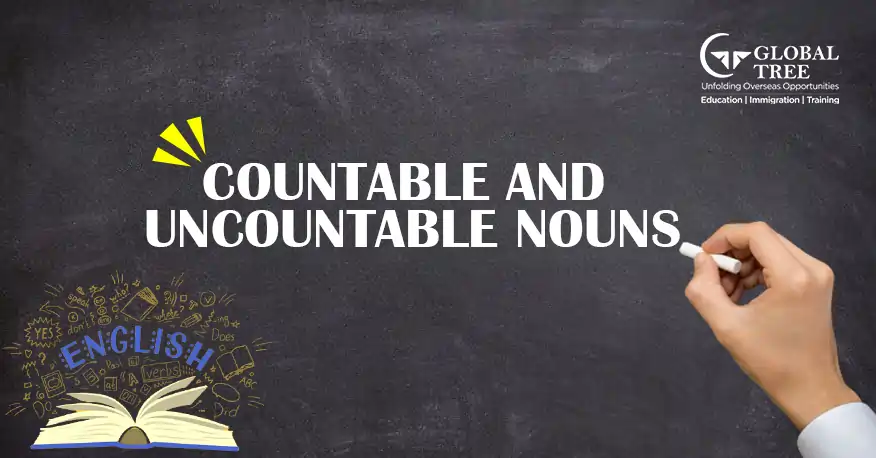Countable and Uncountable Nouns: An All-In-One Reference Dictionary

- Introduction
- What are Countable and Uncountable Nouns?
- Types of Countable and Uncountable Nouns
- Countable and Uncountable Nouns Rules of Grammar
- Countable and Uncountable Nouns List
- How to Identify Countable and Uncountable Nouns?
- What is the Difference Between Countable and Uncountable Nouns?
- Pronouns or Questioning Adverbs used for Uncountable Nouns
- Practice Countable and Uncountable Nouns
- Conclusion
- FAQs for Countable and Uncountable Nouns
Introduction
The concepts of countable and uncountable nouns are cornerstones of English grammatical structure. They have a significant impact on the way we arrange our sentences and help decide whether we employ articles like "a," "an," or "some," among other words. In this long book, we will delve into the realm of countable and uncountable nouns, beginning with an explanation of their classifications and progressing to the provision of vast word lists, examples, and pointers on how to appropriately recognize and apply these sorts of nouns in your writing.
What are Countable and Uncountable Nouns?
Countable and uncountable nouns, as the names suggest, refer to different categories of nouns based on their countability. Let's break down the definitions:
Countable Nouns
Countable nouns are objects, people, or things that can be counted as separate individual units. You can use numbers (e.g., one, two, three) or the indefinite articles "a" or "an" with countable nouns. For example:
- One apple
- Two cats
- An umbrella
Uncountable Nouns
Uncountable nouns, on the other hand, are nouns that represent substances, concepts, or ideas that cannot be counted as individual units. These nouns usually do not take numbers or the indefinite articles "a" or "an." Instead, they are quantified using words like "some," "a little," or "much." For example:
- Some water
- A little information
- Much advice
[Also Learn: The Difference between Affect and Effect]
Types of Countable and Uncountable Nouns
Countable and uncountable nouns can be further categorized into various types based on their characteristics:
Types of Countable Nouns
- Concrete Nouns: These are tangible, physical objects that you can perceive with your senses, such as "book," "car," or "dog."
- Abstract Nouns: These represent concepts, emotions, or qualities, such as "love," "happiness," or "knowledge."
- Collective Nouns: These refer to groups of things or people, such as "team," "family," or "herd."
Types of Uncountable Nouns
- Material Nouns: These nouns denote substances or materials, such as "water," "wood," or "gold."
- Abstract Nouns: Similar to countable abstract nouns, these represent intangible concepts like "freedom," "music," or "beauty."
- Food and Drink Nouns: Categories like "milk," "rice," "coffee," and "sugar" fall into this group.
Countable and Uncountable Nouns Rules of Grammar
Understanding the grammar rules associated with countable and uncountable nouns is essential for constructing grammatically correct sentences. Here are some key points to remember, If you are preparing for IELTS check out this Grammar Guide for your Test prep
Countable Nouns in Grammar
- Singular and Plural Forms: Countable nouns have both singular and plural forms. For example, "cat" (singular) becomes "cats" (plural).
- Articles: You can use the indefinite articles "a" or "an" with singular countable nouns, and the definite article "the" with both singular and plural countable nouns.
- Quantifiers: Countable nouns can be quantified with numbers (e.g., one, two) or other quantifiers like "many" and "few."
Uncountable Nouns in Grammar
- No Singular/Plural Distinction: Uncountable nouns do not have singular or plural forms. They are always treated as singular. For example, "water" remains "water."
- No Indefinite Articles: Uncountable nouns do not take the indefinite articles "a" or "an." Instead, they are often preceded by "some" or "a little."
- Quantifiers: Uncountable nouns are quantified with terms like "some," "a lot of," "much," or "a little."
[Read more: Figures of Speech: Types, Usage and Examples]
Countable and Uncountable Nouns List
To help you understand countable and uncountable nouns better, here are extensive word lists for each category:
Countable Nouns List
|
|
|
|
|
Uncountable Nouns List
|
|
|
|
|
|
[Read More: Simile: What is it? Importance, Usage ]
Examples of Countable Nouns
Let's look at some sentences with countable nouns:
- I have two dogs.
- She bought a book.
- There are three cars in the parking lot.
- He needs a pen for his exam.
- The classroom has thirty students.
Examples of Uncountable Nouns
Now, consider examples with uncountable nouns:
- Please pass me some water.
- She has a lot of information about the project.
- His advice was helpful.
- We need to buy a little furniture for the living room.
- Music brings me joy.
[Best Tips: To boost your PTE score]
How to Identify Countable and Uncountable Nouns?
Identifying countable and uncountable nouns can be tricky, but there are some general rules to follow:
Countable Nouns Identification
- Look for singular and plural forms. If the noun can be pluralized, it's likely countable.
- Check for articles. Countable nouns can take "a," "an," or "the."
- Consider quantifiers. If you can use numbers or words like "many" or "few," it's probably countable.
- Uncountable Nouns Identification
- No plural forms. Uncountable nouns do not change in form.
- No indefinite articles. They do not use "a" or "an."
- Use of quantifiers like "some," "much," or "a little."
What is the Difference Between Countable and Uncountable Nouns?
The main difference between nouns that can be counted and those that can't is whether or not they can be counted separately. Countable nouns can be counted individually, but uncountable words can't. This difference changes the way we use articles, quantifiers, and the form of our sentences.
[Read More: What is the difference between: Homophones, Homographs, Homonyms]
| Countable Nouns | Uncountable Nouns |
|---|---|
|
They can be expressed in numbers |
Cannot be expressed in numbers |
|
Has both singular and plural forms |
Do not have plural form |
|
Can be changed to plural |
Cannot be changed to plural |
|
Uses the “how many” form |
Uses the “how much” form |
Pronouns or Questioning Adverbs used for Uncountable Nouns
When referring to uncountable nouns, it's essential to use pronouns like "it," "this," "that," or "these" instead of numbers or articles. Additionally, questioning adverbs like "how much" or "how many" can help you inquire about uncountable nouns:
- How much water do you need?
- I have some coffee. Do you want some too?
- This music is beautiful.
Irregular Uncountable Nouns
Some uncountable nouns have irregular plural forms, which means they do not follow the typical "-s" or "-es" rule. For example:
-
Child (singular) becomes children (plural)
- Man (singular) becomes men (plural)
[You make also like: Simple Tips for a new German Learner]
Practice Countable and Uncountable Nouns
Let's practice with a few exercises:
Exercise 1: Identify whether the following nouns are countable (C) or uncountable (U).
- The children are playing in the garden.
- I don't like milk.
Exercise 2: Fill in the gaps using one of the following: many/much/a lot of.
- I haven't heard ___________ news about the cyclone in India. (much)
- There aren't ___________ dance classes offered in the university curriculum. (many)
- I cannot go out today because I've got ___________ work. (a lot of)
- It is often said that men who have only traveled in their own country don't have ___________ tolerance for others compared to people who have traveled abroad. (much)
- ___________ literature that children read at school is fictional. (much)
Answers:
Exercise 1:
- The children are playing in the garden. (C) - Countable
- I don't like milk. (U) - Uncountable
Exercise 2:
- I haven't heard much news about the cyclone in India. (much)
- There aren't many dance classes offered in the university curriculum. (many)
- I cannot go out today because I've got a lot of work. (a lot of)
- It is often said that men who have only traveled in their own country don't have much tolerance for others compared to people who have traveled abroad. (much)
- Much literature that children read at school is fictional. (much)
[Check out: Tips to Ace your PTE Exam]
Conclusion
Anyone who wants to learn English grammar needs to know the difference between countable and uncountable words.
Even though these two types of words seem simple, they have a big effect on how we talk and how our sentences are put together.
As you continue to learn English, keep in mind that practice is the most important thing. Pay close attention to how countable and uncountable nouns are used when you do tasks, read, write, and talk in English.
The more you learn about the language, the more confidence you'll feel in your ability to use these basic grammar rules well.
FAQs for Countable and Uncountable Nouns
1. Can a noun be both countable and uncountable?
A: Some nouns can be used both in ways that count and ways that don't count, based on the situation. For example, the word "fruit" can mean either a specific kind of fruit or fruit in general.
2. What are some common quantifiers for uncountable nouns?
A: Some common ways to talk about the amount of an uncountable word are "some," "much," "a little," "a lot of," and "any."
3. Are there exceptions to the rules for countable and uncountable nouns?
A: Some words don't follow the usual rules of English, and that's okay. It's important to use books and language guides in certain situations.
4. Can uncountable nouns have possessive forms?
A: Yes, even nouns that can't be counted can have forms that show ownership or connection. For instance, "John's knowledge of art is impressive."
5. What's the best way to improve my understanding of countable and uncountable nouns?
A: Practice is crucial. Try to use both countable and uncountable nouns in your work and conversations. Reading and listening to English will also help you understand these ideas better.


